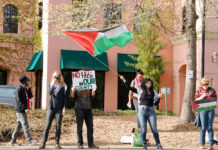This week’s newspaper includes our annual Harvest Edition. For the past several decades we have provided this extended coverage of the year’s growing season, the work and weather, the people and the crops and the other news that are part of the latest chapter of Sonoma County’s agricultural heritage.
Our 2015 report focuses on the dominant winegrape crop, but also includes stories about the ongoing drought, the new niche markets for apples, farmer profiles and some touches of controversy.
Farmer and winery owner Lou Preston reflects back on his own ag roots while casting predictions on what our county’s farming future might look like in the decades to come.
There are comments and challenges raised about land use, water rights and the definition of such terms as “sustainability” and “green washing.” One old-timer, Richard Rued of Dry Creek Valley, laments about “astronomical” land prices while farming students at the Santa Rosa Junior College’s Shone Farm are seen as the “changing faces of agriculture.”
Since when did farming turn controversial? Why do some farmers feel so defensive about converting old orchards to better-paying vineyards? What’s wrong with adding new marketing twists like wine weekends or celebrity chef tours if it helps farmers sell their crops?
There have been big changes here since we published our first annual Harvest Edition in 1982. Perhaps the biggest change has been that Sonoma County has doubled in population since that year and few of these new residents are farmers.
Sonoma County’s earliest European settlers were almost all farmers, growing grain, grapes, livestock and food for nearby Gold Rush and San Francisco fortune-seekers. Agriculture is still Sonoma County’s dominant industry, last year totalling $900 million in raw crop sales. That’s not counting billions more in wine, gourmet farm products, high-quality foods and related visitor experiences and purchases.
This is a continuing legacy dating from 1935 when Sonoma County was the 10th highest producing farming county in the United States. That’s when poultry was the top industry here and there were still more prunes planted than grapes. Hops took over the top ranking a decade later, followed by an expansion of dairy herds here and challenged by a very large apple growing industry that peaked at 26,000 acres of orchards just after World War II. Today, of course, winegrapes are the top local crop, equalling two-thirds ($593 million) of the $900 million 2014 output.
We should never forget what botanist Luther Burbank said about his adopted home, Sonoma County, being “the chosen place of all the earth as far as nature is concerned. Here any plant can grow.”
Sonoma County’s farmers are now far-outnumbered by the rest of us, with the county’s population at 495,000. Sometimes our farmers don’t get all the praise they deserve. In times of drought, land use changes, new watershed rules or habitat regulations — plus a shifting population base — agriculture sometimes garners unwanted attention or controversy.
In 1999, the county’s Board of Supervisors saw it necessary to pass a Right To Farm Ordinance to “conserve, protect, enhance and encourage” agricultural pursuits and traditional farming. The ordinance requires all people be notified at the time of property sales within or adjacent to land zoned for agriculture about the “inconvenience of noise, odors, fumes, dust, smoke, insects, operation of machinery day and night and use of manure and pesticides.”
County Agriculture Commissioner Tony Linegar, in this year’s Harvest Edition reminds all of us that our farmers do more than just put food and wine on our tables. Farm, ranch and vineyard land is where our drought-stricken acquifers and groundwater will be recharged. It is rural lands that provide wildlife habitat, beautiful scenery and homesteads for many of us non-farmers.
If there is any real controversy here, it is about how we will continue to preserve our rich and varied farming legacy instead of over-regulating or misunderstanding it.
— Rollie Atkinson
36.3
F
Healdsburg
February 12, 2025







